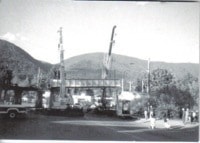In 1988, decades after it was erected, the old Canadian National Railway trestle that spanned the Cowichan River and South Shore Road in the center of town, was removed. The nostalgic daily sights and sounds of trains and their whistles, as well as the impact they had on the area, was over.
The reality was far different from the nostalgia that was generated that final day. Although the trestle was necessary in that it was part of the rail line from Victoria to Youbou, it was also crucial to the economy of the area. A big silver overpass, it loomed over the main street and many logging trucks passed under it on a daily basis for countless years. It was more or less taken for granted, and sometimes ignored. Sure, it wasn’t attractive, but it was a fixture in town.
Problems arose early on, as far back as the 1940s, when loaded logging trucks piled high with lumber began to hit the top of the trestle. Rather than take the position that the loads were to high, the Chamber of Commerce of the day, representing the view of the townsfolk, complained that the trestle was too low.
The Aug. 11, 1958 issue of the local newspaper, The Lake News, reported, “Fear had been expressed that logs may be knocked off logging trucks.” The problem wasn’t so much that the loads hit the trestle at 40 miles per hour, firing “wooden missiles,” but the immediate danger to pedestrians and motorists. That was what prompted the complaints — and rightly so.
The Lake News also reported that “The CNR trestle over the main road in Lake Cowichan bares scars as a result of high loads on trucks passing underneath. Drivers expressed their opinion in not-to-delicate words.” The editor offered his own solution to the problem by recommending that motorists take an alternate route, via King George Street, Cowichan Avenue or the Wellington Avenue. The advice was not well received.
For many more years, pedestrians (including this author) and motorists dodged flying logs until 1988, when the last train from Youbou made its final run. It was with mixed emotions, as townsfolk said goodbye to the end of an era. The final act took place in September when the trestle was removed and trucked to it’s new home at the British Columbia Forest Discovery Centre near Duncan.
